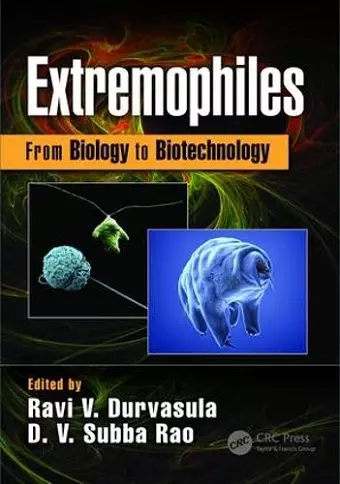Extremophiles
From Biology to Biotechnology
Ravi V Durvasula editor D V Subba Rao editor
Format:Hardback
Publisher:Taylor & Francis Inc
Published:25th Jan '18
Currently unavailable, and unfortunately no date known when it will be back
This hardback is available in another edition too:
- Paperback£51.99(9780367572327)

Highly recommended by CHOICE, Oct 2018
Extremophiles are nature’s ultimate survivors, thriving in environments ranging from the frozen Antarctic to abyssal hot hydrothermal vents. Their lifeforms span bacteria to fishes, and are categorized as halophiles from hypersaline environments, acidophiles from acidic waters, psychrophiles from cold habitats, and thermophiles from warm waters. Extremophiles: From Biology to Biotechnology comprehensively covers the basic biology, physiology, habitats, secondary metabolites for bioprospecting, and biotechnology of these extreme survivors. The chapters focus on the novel genetic and biochemical traits that lend these organisms to biotechnological applications.
Couples studies of marine extremophile biology/genomics and extremophile culture for biotechnological applications with the latest advances in bio-prospecting and bio-product development
Includes practical experiments that a laboratory can use to replicate extreme habitats for research purposes
Presents latest advances in extremophile genomics to give the reader a better understanding of the regulatory mechanisms of extremophiles
Offers insights into the production of commercially important extremozymes, carotenoids, bioactive compounds and secondary metabolites of medicinal value.
This unique guide serves as a resource for biotechnologists who wish to explore extremophiles for their commercial potential, as well as a valuable reference for teaching undergraduate, graduate and postgraduate students.
Few books focus entirely on the fascinating organisms that exist in the world’s harshest environments. In deep-sea brine pools, in deserts, and within ice, microbes have developed unique mechanisms to live and reproduce in salt, acid, heat, cold, and other extreme conditions. In Extremophiles: From Biology to Biotechnology, the editors have assembled a wide-ranging exploration centered on organisms' structural, metabolic, and genomic adaptations for surviving in extreme environments. Contributions include experts in biochemistry, microbiology, food science, and medicine. This book distinguishes itself from others in its category by devoting some discussion to the utility of extremophiles as a source of secondary metabolites and other biotechnological applications. These products include phycocyanins, enzymes, drug candidates, nanoparticles, and carotenoids. For those interested in working with extremophiles, an appendix containing a compilation of recent information for their cultivation and a glossary are located at the back of the book. Overall, this text is well organized and serves as an important reference for scientists in this area of research. It will also be valuable to undergraduate and graduate collections relating to microbial diversity or biotechnology.
Summing Up: Highly recommended. Upper-division undergraduates through faculty and professionals.
--M. C. Pavao, Worcester State University, in CHOICE October 2018
Few books focus entirely on the fascinating organisms that exist in the world’s harshest environments. In deep-sea brine pools, in deserts, and within ice, microbes have developed unique mechanisms to live and reproduce in salt, acid, heat, cold, and other extreme conditions. In Extremophiles: From Biology to Biotechnology, the editors have assembled a wide-ranging exploration centered on organisms' structural, metabolic, and genomic adaptations for surviving in extreme environments. Contributions include experts in biochemistry, microbiology, food science, and medicine. This book distinguishes itself from others in its category by devoting some discussion to the utility of extremophiles as a source of secondary metabolites and other biotechnological applications. These products include phycocyanins, enzymes, drug candidates, nanoparticles, and carotenoids. For those interested in working with extremophiles, an appendix containing a compilation of recent information for their cultivation and a glossary are located at the back of the book. Overall, this text is well organized and serves as an important reference for scientists in this area of research. It will also be valuable to undergraduate and graduate collections relating to microbial diversity or biotechnology.
Summing Up: Highly recommended. Upper-division undergraduates through faculty and professionals.
--M. C. Pavao, Worcester State University, in CHOICE October 2018
ISBN: 9781498774925
Dimensions: unknown
Weight: 1100g
399 pages